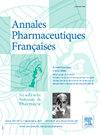Cardiovascular disease and thrombosis: Intersections with the immune system, inflammation, and the coagulation system
IF 1
Q4 PHARMACOLOGY & PHARMACY
引用次数: 0
Abstract
The coagulation and immune system, both essential physiological systems in the human body, are intricately interconnected and play a critical role in determining the overall health of patients. These systems collaborate via various shared regulatory pathways, such as the Tissue Factor (TF) Pathway. Immunological cells that express TF and generate pro-inflammatory cytokines have the ability to affect coagulation. Conversely, coagulation factors and processes have a reciprocal effect on immunological responses by stimulating immune cells and regulating their functions. These interconnected pathways play a role in both preserving well-being and contributing to a range of pathological disorders. The close relationship between blood clotting and inflammation in the development of vascular disease has become a central focus of clinical study. This research specifically examines the crucial elements of this interaction within the contexts of cardiovascular disease and acute coronary syndrome. Tissue factor, the primary trigger of the extrinsic coagulation pathway, has a crucial function by inducing a proinflammatory reaction through the activation of coagulation factors. This, in turn, initiates coagulation and subsequent cellular signalling pathways. Protease-activated receptors establish the molecular connection between coagulation and inflammation by interacting with activated clotting factors II, X, and VII. Thrombosis, a condition characterised by the formation of blood clots, is the most dreaded consequence of cardiovascular disorders and a leading cause of death globally. Consequently, it poses a significant challenge to healthcare systems. Antithrombotic treatments efficiently target platelets and the coagulation cascade, but they come with the inherent danger of causing bleeding. Furthermore, antithrombotics are unable to fully eliminate thrombotic events, highlighting a treatment deficiency caused by a third mechanism that has not yet been sufficiently addressed, namely inflammation. Understanding these connections may aid in the development of novel approaches to mitigate the harmful mutual exacerbation of inflammation and coagulation. Gaining a comprehensive understanding of the intricate interaction among these systems is crucial for the management of diseases and the creation of efficacious remedies. Through the examination of these prevalent regulatory systems, we can discover novel therapeutic approaches that specifically target these complex illnesses. This paper provides a thorough examination of the reciprocal relationship between the coagulation and immune systems, emphasising its importance in maintaining health and understanding disease processes. This review examines the interplay between inflammation and thrombosis and its role in the development of thrombotic disorders.
La coagulation et le système immunitaire, deux systèmes physiologiques essentiels du corps humain, sont étroitement liés et jouent un rôle essentiel dans la détermination de la santé globale des patients. Ces systèmes collaborent via diverses voies de régulation partagées, telles que la voie du facteur tissulaire (TF). Les cellules immunologiques qui expriment le TF et génèrent des cytokines pro-inflammatoires ont la capacité d’affecter la coagulation. À l’inverse, les facteurs et processus de coagulation ont un effet réciproque sur les réponses immunologiques en stimulant les cellules immunitaires et en régulant leurs fonctions. Ces voies interconnectées jouent un rôle à la fois dans la préservation du bien-être et dans la survenue d’une série de troubles pathologiques. La relation étroite entre la coagulation sanguine et l’inflammation dans le développement des maladies vasculaires est devenue un objectif central des études cliniques. Cette recherche examine spécifiquement les éléments cruciaux de cette interaction dans les contextes de maladies cardiovasculaires et de syndrome coronarien aigu. Le facteur tissulaire, principal déclencheur de la voie extrinsèque de la coagulation, joue un rôle crucial en induisant une réaction pro-inflammatoire par l’activation des facteurs de coagulation. Ceci, à son tour, initie la coagulation et les voies de signalisation cellulaire ultérieures. Les récepteurs activés par la protéase établissent le lien moléculaire entre la coagulation et l’inflammation en interagissant avec les facteurs de coagulation activés II, X et VII. La thrombose, une affection caractérisée par la formation de caillots sanguins, est la conséquence la plus redoutée des troubles cardiovasculaires et l’une des principales causes de décès dans le monde. Cela pose donc un défi important aux systèmes de santé. Les traitements antithrombotiques ciblent efficacement les plaquettes et la cascade de coagulation, mais ils comportent le risque inhérent de provoquer des saignements. De plus, les antithrombotiques ne parviennent pas à éliminer totalement les événements thrombotiques, mettant en évidence un déficit thérapeutique provoqué par un troisième mécanisme encore peu abordé, à savoir l’inflammation. Comprendre ces liens peut aider au développement de nouvelles approches pour atténuer l’exacerbation mutuelle néfaste de l’inflammation et de la coagulation. L’acquisition d’une compréhension globale de l’interaction complexe entre ces systèmes est cruciale pour la gestion des maladies et la création de remèdes efficaces. Grâce à l’examen de ces systèmes de régulation répandus, nous pouvons découvrir de nouvelles approches thérapeutiques ciblant spécifiquement ces maladies complexes. Cet article propose un examen approfondi de la relation réciproque entre la coagulation et le système immunitaire, en soulignant son importance dans le maintien de la santé et la compréhension des processus pathologiques. Cette revue examine l’interaction entre l’inflammation et la thrombose et son rôle dans le développement de troubles thrombotiques.

心血管疾病与血栓形成:与免疫系统、炎症和凝血系统的交集。
凝血系统和免疫系统都是人体重要的生理系统,它们之间有着错综复杂的联系,在决定患者整体健康方面发挥着至关重要的作用。这些系统通过组织因子(TF)途径等各种共享调控途径相互协作。表达 TF 并产生促炎细胞因子的免疫细胞能够影响凝血功能。相反,凝血因子和凝血过程通过刺激免疫细胞并调节其功能,对免疫反应产生相互影响。这些相互关联的途径既能维护人体健康,也能导致一系列病理紊乱。凝血和炎症在血管疾病发展过程中的密切关系已成为临床研究的核心重点。这项研究特别探讨了心血管疾病和急性冠状动脉综合征中这种相互作用的关键因素。组织因子是外凝血途径的主要触发因子,其关键作用是通过激活凝血因子诱发促炎反应。这反过来又启动了凝血和随后的细胞信号通路。蛋白酶活化受体通过与活化的凝血因子 II、X 和 VII 相互作用,建立了凝血与炎症之间的分子联系。血栓形成是心血管疾病最可怕的后果,也是全球死亡的主要原因。因此,它给医疗保健系统带来了巨大挑战。抗血栓治疗能有效地针对血小板和凝血级联反应,但也有引起出血的固有危险。此外,抗血栓药物无法完全消除血栓事件,这凸显了尚未充分解决的第三个机制(即炎症)造成的治疗缺陷。了解这些联系有助于开发新的方法,减轻炎症和凝血相互加重的危害。全面了解这些系统之间错综复杂的相互作用对于疾病的治疗和创造有效的疗法至关重要。通过研究这些普遍存在的调节系统,我们可以发现专门针对这些复杂疾病的新型治疗方法。本文深入探讨了凝血系统和免疫系统之间的相互关系,强调了它们在维持健康和了解疾病过程中的重要性。这篇综述探讨了炎症与血栓形成之间的相互作用及其在血栓性疾病发展中的作用。
本文章由计算机程序翻译,如有差异,请以英文原文为准。
求助全文
约1分钟内获得全文
求助全文
来源期刊

Annales pharmaceutiques francaises
PHARMACOLOGY & PHARMACY-
CiteScore
1.70
自引率
7.70%
发文量
98
期刊介绍:
This journal proposes a scientific information validated and indexed to be informed about the last research works in all the domains interesting the pharmacy. The original works, general reviews, the focusing, the brief notes, subjected by the best academics and the professionals, propose a synthetic approach of the last progress accomplished in the concerned sectors. The thematic Sessions and the – life of the Academy – resume the communications which, presented in front of the national Academy of pharmacy, are in the heart of the current events.
 求助内容:
求助内容: 应助结果提醒方式:
应助结果提醒方式:


